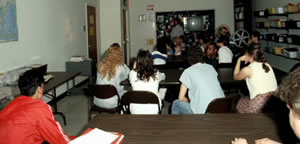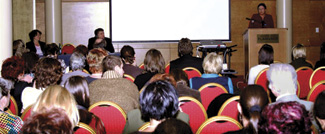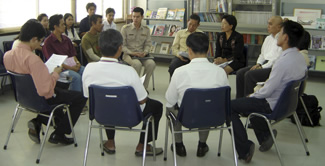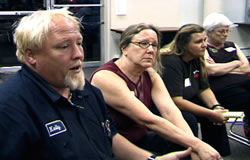News & Announcements
- Details
- Written by Laura Mirsky
[The goals and philosophy of restorative practices are, of course, consistent with those of programs promoting social and emotional learning. These findings should therefore buoy the confidence of those working in schools to enhance social and emotional learning by means of restorative practices.]
The study showed that students who participate in school-based programs that focus on social and emotional learning, compared to students who do not, improve significantly in terms of social and emotional skills; attitudes about themselves, others and school; social and classroom behavior; emotional distress such as stress, anxiety and depression; achievement test scores (11 percentage points higher); and school grades.
- Details
- Written by Lynn M. Welden
This article by Lynn M. Welden talks about how restorative practices is spreading in schools throughout New South Wales and South Australia, aided by multi-school summits or forums, where staff meet to share their implementation experiences.
- Details
- Written by Lynn M. Welden
 West Beach Public School pupils and teacher Rosemary Griffin participate in SW Metro District’s Restorative Directions Day, engaging in a circle process.Two Australian educators are making an important difference in the emotional and academic vitality of the schools in their regions. Lyn Doppler has been principal of the award-winning Rozelle Public School in Sydney, New South Wales, since 2002. Lesley Oliver is manager of Student Inclusion and Wellbeing for the government of South Australia’s Department of Education and Children’s Services (DECS), representing the South West (SW) Metro District of Adelaide. Each has been recognized for her leadership role in embedding restorative practices in Australian schools.
West Beach Public School pupils and teacher Rosemary Griffin participate in SW Metro District’s Restorative Directions Day, engaging in a circle process.Two Australian educators are making an important difference in the emotional and academic vitality of the schools in their regions. Lyn Doppler has been principal of the award-winning Rozelle Public School in Sydney, New South Wales, since 2002. Lesley Oliver is manager of Student Inclusion and Wellbeing for the government of South Australia’s Department of Education and Children’s Services (DECS), representing the South West (SW) Metro District of Adelaide. Each has been recognized for her leadership role in embedding restorative practices in Australian schools.
Restorative practices (RP) in schools is based on the principles of restorative justice. Police officer Terry O’Connell was one of the restorative justice pioneers in Australia in the early 1990s. Currently director of Real Justice Australia (an affiliate of the International Institute for Restorative Practices), Terry O’Connell found that bringing offenders and victims and their supporters together in a face-to-face meeting had a beneficial effect on the healing process. His “scripted model,” used in facilitating such restorative conferences, has had enormous impact on criminal justice throughout the world.
- Details
- Written by Laura Mirsky
 A classroom at the first CSF school, in Sellersville, Pennsylvania, USAThirty years ago, in December 1977, the Community Service Foundation (CSF) welcomed Jimmy*, its first client. Bucks County Juvenile Court (Pennsylvania, USA), had referred Jimmy, 15 and just released from juvenile detention, to CSF as a test case. A brain-damage victim—probably at the hands of his father—Jimmy liked to steal large construction vehicles and drive them around.
A classroom at the first CSF school, in Sellersville, Pennsylvania, USAThirty years ago, in December 1977, the Community Service Foundation (CSF) welcomed Jimmy*, its first client. Bucks County Juvenile Court (Pennsylvania, USA), had referred Jimmy, 15 and just released from juvenile detention, to CSF as a test case. A brain-damage victim—probably at the hands of his father—Jimmy liked to steal large construction vehicles and drive them around.Ted Wachtel, now president of the International Institute for Restorative Practices (IIRP), had been a public high school teacher. Frustrated by the way he saw “difficult” youth being treated, he left his job and, in March 1977, obtained a private school license for CSF. By December, CSF had a staff—Ted and two short-term employees—and a home—a room in a local church. Jimmy spent nights with friends of the Wachtels.
- Details
- Written by Rodney Skager
Rodney Skager is Professor Emeritus, Graduate School of Education and Information Studies, University of California, Los Angeles, Co-Director of the California Student Survey sponsored by the Office of the California Attorney General, and consultant to the Drug Policy Alliance. This paper was originally published in October 2007 as “More Effective and Humane Youth Policy Starts by Treating Youth with Respect,” in D.L. White, B.C. Glenn, and A. Wimes (eds.), Proceedings of Persistently Safe Schools: The 2007 National Conference on Safe Schools, pp. 243-250, Washington, DC: Hamilton Fish Institute, The George Washington University.
Adults often perceive teen-age behavior as oppositional. In this they are right. The question is: oppositional to what and why?
The “what” part is obvious. Opposition takes the form of doing things that adults forbid or discourage. This includes joining gangs, using drugs or getting drunk, having sex, truancy and damaging school property, physical risk-taking, bizarre dress, tattoos and piercing, adult-toxic taste in entertainment, disrespectful behavior to adult authority, and so on. These choices and associated behaviors are expressions of something larger than individual resentment. They are the product of a teen-age subculture that was visible by the mid-20th century and has developed spectacularly since that time.
- Details
- Written by Borbála Fellegi
 A plenary speech on day one of the conference, photography by Dávid VadóczBorbála Fellegi is a Ph.D. researcher at Eötvös Loránd (ELTE) University, Budapest, Hungary, in the field of social policy and criminology, with a special focus on the potential of restorative justice in criminal matters. She authored this report after attending the 10th IIRP International Conference.
A plenary speech on day one of the conference, photography by Dávid VadóczBorbála Fellegi is a Ph.D. researcher at Eötvös Loránd (ELTE) University, Budapest, Hungary, in the field of social policy and criminology, with a special focus on the potential of restorative justice in criminal matters. She authored this report after attending the 10th IIRP International Conference.“Participation, responsibility-taking, communication, community, caring, restoration, understanding, acceptance” –these concepts were the focus of the three-day long conference organized by the International Institute for Restorative Practices in cooperation with the Community Service Foundation of Hungary.
Several models–such as conferencing, circles, mediation and family group decision making–are being applied all over the world: in many countries of Europe, America, Asia, Australia and Africa.
- Details
- Written by IIRP
View papers from the 10th IIRP World Conference, held November 7-9, 2007, in Budapest, Hungary.
- Details
- Written by Abbey J. Porter
 A family and community group conference (FCGC) in Thailand.For Thailand, restorative practices have provided a culturally relevant means of dealing with criminal offenders, especially juveniles. Over the past several years, the Thais have developed a restorative conferencing model that they have used in thousands of cases, with highly encouraging results.
A family and community group conference (FCGC) in Thailand.For Thailand, restorative practices have provided a culturally relevant means of dealing with criminal offenders, especially juveniles. Over the past several years, the Thais have developed a restorative conferencing model that they have used in thousands of cases, with highly encouraging results.Spearheading the restorative justice initiative is Wanchai Roujanavong, director general of Thailand’s Department of Corrections. He attributes the success of Thailand’s restorative venture in part to its cultural fit. “Thais are a very compromising people,” he said. “They want to live in harmony.”
Roujanavong and his colleagues developed a system called family and community group conferencing (FCGC). Based partly on the IIRP’s restorative conferencing model, it involves the victim, the offender and his or her family and members of the community in a conference in which participants discuss how they were affected by the incident in question and make an agreement to repair the harm. In most cases, conferences are used in place of court prosecution.
- Details
- Written by Lynn M. Welden
 Members of the community near the CSF Buxmont Trevose school have a circle meeting to share their feelings about neighborhood vandalism and brainstorm ideas to remedy the problem.When ongoing vandalism by local youth — graffiti, broken windows, littering — affected Buxmont Academy Trevose and the surrounding neighborhood of families and shop owners, school coordinator Ed Krajewski decided to apply a restorative approach used at the school, one of eight alternative schools operated by the Community Service Foundation and Buxmont Academy (CSF Buxmont) in Pennsylvania, USA (demonstration programs of the IIRP).
Members of the community near the CSF Buxmont Trevose school have a circle meeting to share their feelings about neighborhood vandalism and brainstorm ideas to remedy the problem.When ongoing vandalism by local youth — graffiti, broken windows, littering — affected Buxmont Academy Trevose and the surrounding neighborhood of families and shop owners, school coordinator Ed Krajewski decided to apply a restorative approach used at the school, one of eight alternative schools operated by the Community Service Foundation and Buxmont Academy (CSF Buxmont) in Pennsylvania, USA (demonstration programs of the IIRP).
“I had been spending more and more time dealing with this issue,” said Krajewski. Added Pam Thompson, Krajewski’s colleague and assistant director of CSF Buxmont’s Day Treatment Program, “Neighbors and businesses were being harassed, but they weren’t communicating with each other. People were living in fear, not calling the police. Something had to be done.”
- Details
- Written by Vidia Negrea
Paper by Vidia Negrea, presented in a plenary session at "Improving Citizenship & Restoring Community," the IIRP''s 10th International Institute for Restorative Practices World Conference, November 7-9, 2007, Budapest, Hungary.

Restorative Works Year in Review 2023 (PDF)
All our donors are acknowledged annually in Restorative Works.
